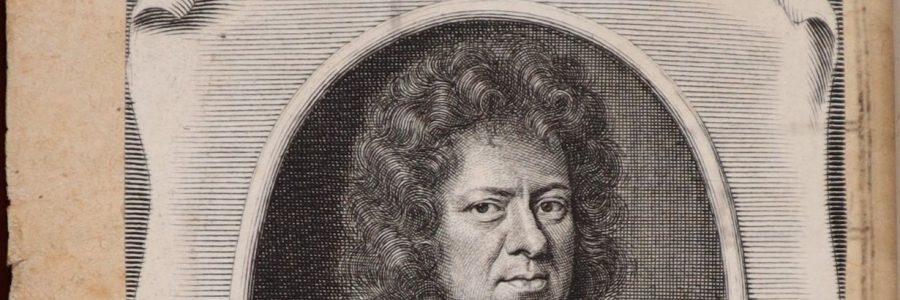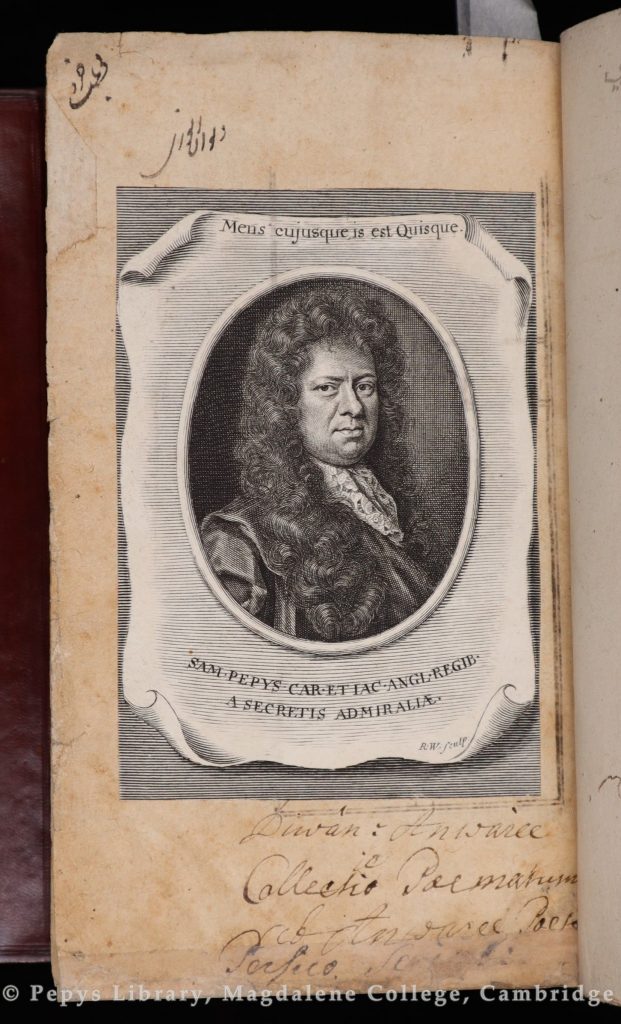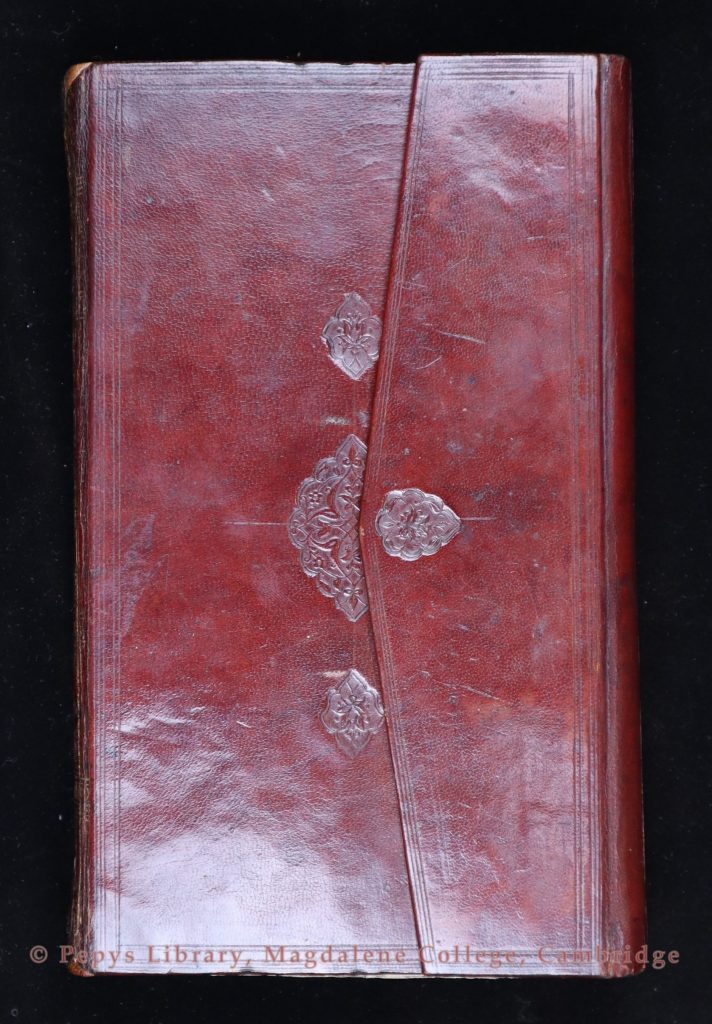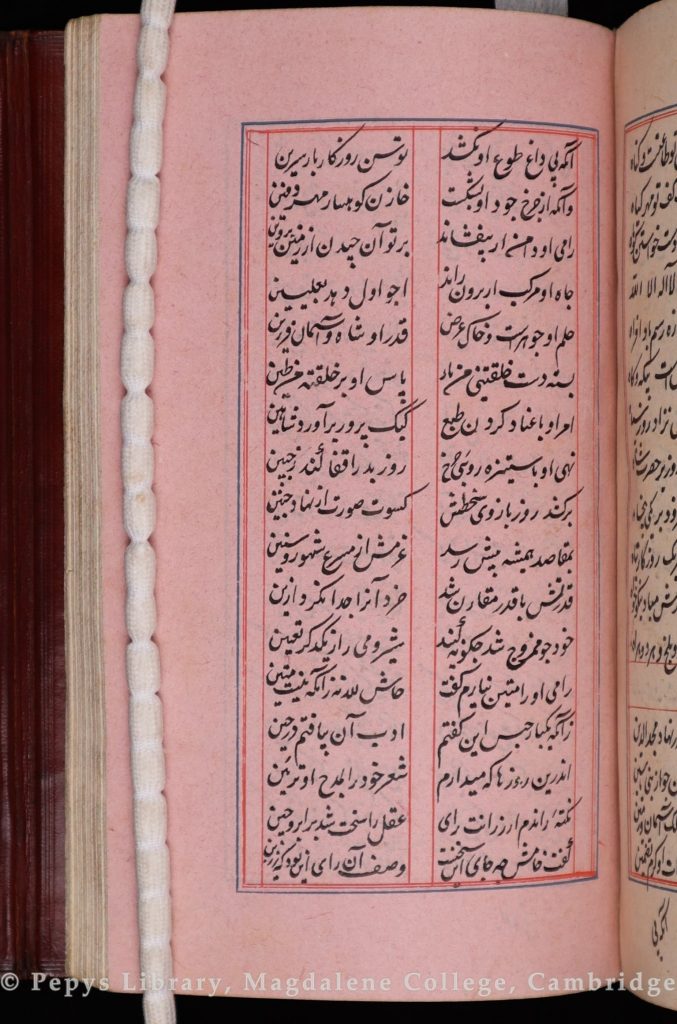
A Persian Manuscript for Samuel Pepys: Naval Networks and Indology in Restoration England
This post is by the inaugural Oschinsky Research Associate, Dr James White. James is working with a core group of forty Arabic and Persian manuscripts which date from the thirteenth century through to the sixteenth century, held in the University Library and the Cambridge colleges and museums. The aim of his research is to map the intertextual connections (i.e. instances of text reuse) between these manuscripts, and show how communities of authors, scribes and readers active across North Africa, the Middle East and South Asia were connected through circulation prior to the nineteenth century.
Pepys Library 1281 is a curious manuscript. Its spine is gilded and decorated to conform with the other volumes in the collection, and so a visitor to the great diarist’s library might not have given it a second glance. On removing it from the shelf and examining it more closely, however, their interest might have been piqued. The binding, which is original and in excellent condition, is of maroon leather on pasteboard, with an envelope flap – an additional piece of board attached by a flexible join to the back cover, which sits between the front cover and the fly-leaf to protect the codex. This is a common feature of Islamicate bookbinding. The front and back covers are also atypical for the library, being decorated with a central mandorla and detached pendants containing floral motifs in relief, while the flap has a single pendant. On opening the volume, one sees Pepys’ bookplate (above), and his inscription: “Diwân i Anwarèe, i.e. Collectio Poematum ab Anwaree Poetâ Persico scr[ipta]” (‘The dīvān of Anvarī, i.e. a collection of poems written by the Persian poet Anvarī’).
The volume is indeed the dīvān, or collected poetry, of the great medieval Persian poet Anvarī (d. 556/1160-61, or later), who found success writing under the Great Saljuq dynasty of Iran.[i] Affiliated most closely with the court of Sultan Sanjar (r. 511/1118-552/1157), Anvarī is famous for his panegyrics, pieces in which he developed a political vision for his patrons and their audiences.[ii] His verse is dense, and many late medieval and early modern commentaries were written to explain it, but despite the opacity of his poetry, he was popular prior to modernity.[iii] The Mughal emperor Akbar the Great (d. 1014/1605) commissioned his own, illuminated copy of Anvarī’s collected works, showing the canonical status which the poet attained in the centuries after his death, including in early modern Persianate South Asia.[iv]
Pepys’ copy of the dīvān is far less lavish than the emperor Akbar’s, but it too was almost certainly made in India in the early modern era, in all likelihood only a few decades before it entered Pepys’ collection. The text is copied on a mixture of papers, and by multiple hands. The most common paper is a cream-coloured wove, typical of Persian manuscripts made in India, but there are also a few leaves coloured orange and pink, which are present at moments of particular confusion in the collation of the quires; they may be addenda made before binding. The text box on each page is ruled in blue, and the columns in red. A minute nastaʿlīq hand gives way to a coarser, bolder one later on in the codex. There is no colophon, but a date of production around 1600 seems appropriate.
Pepys was not a scholar of Middle Eastern and South Asian cultures, and he did not know Persian, so the presence of PL 1281 in the library is certainly intriguing. Why and how did it come into his possession? One could explain the volume away as a curiosity connected to Pepys’ work for the Navy Board, a rarity brought back by a friend or a colleague who had been to India, which Pepys added to the library and forgot all about. But there is a bigger story here, which concerns Pepys’ fascination with writing systems, and the field of global intellectual history which was rapidly opening up before him and his contemporaries. Mediating between scholarly and political networks, and between institutions such as the Royal Society and the East India Company, Pepys became a small but significant player in the circulation of knowledge about South Asia in seventeenth-century England.
While Pepys’ inscription on the fly-leaf of PL 1281 shows that he had been informed about the contents of the manuscript by someone who could read it, his own catalogues of his library demonstrate that he was not interested in the book for its literary content. In the catalogue of 1700, PL 1281 is simply labelled ‘A Persian MSS’. Through the description in the Appendix Classica, however, we gain more of an insight into how Pepys viewed it: he catalogues the manuscript as ‘Character – Samples of ye Persian’. Other volumes are described as ‘Character – Samples of ye Chinese’, and ‘Character – Samples of ye Slavonian’. This indicates that Pepys was concerned with the manuscript as an example of Perso-Arabic script letterforms, and, more broadly, that he also procured samples of writing in other non-Latin writing systems. Such an interest is a logical extension of his work on ciphers and his use of shorthand. It would seem unlikely that he ever intended to actively use Persian or Cyrillic letters, or indeed Chinese characters, in the formulation of a cryptographic system. It is more probable that acquiring these samples constituted tentative steps towards his friend Humphrey Wanley’s vision of “a collection…of specimens of the writings ‘of every Countrey & Age, digested Regularly according to their respective Antiquities’.”[v]
Looking at Pepys’ collection more broadly, evidence of his encyclopaedic interests in global history and culture is ubiquitous. He owned copies of the Qurʾān (PL 1096), the Gospels in Romanized Malay (PL 1323), and d’Herbelot’s Bibliothèque orientale (PL 2793, first published 1697), a vast encyclopaedia of ‘Oriental’ knowledge principally derived from Arabic and Turkish works of bio-bibliography. Travel literature also abounds, including Anthony Sherley’s (d. 1635) and Sir John Chardin’s (d. 1713) narratives of their travels to Persia (PL 1216; PL 2336), John Fryer’s (d. 1733) travels to Persia and East India (PL 2358) and Jean-Baptiste Tavernier’s (d. 1689) account of his six voyages (PL 2406-7). It is remarkable that many of these books were published later on in Pepys’ life and must have entered his collection very soon after being printed. For Pepys, these works would have represented new, positive knowledge about the political systems, trade, medicine, flora, fauna and geology of the Middle East and South Asia.
While PL 1281 does not contain any notes which cast light on how it was collected and came into Pepys’ possession, it is clear that Pepys maintained connections with East India Company men. In 1703, for example, he corresponded with Thomas Pitt, the Governor of Fort St. George, Madras.[vi] In around 1698, he had facilitated the donation of a gift from the East India Company to the Royal Society, about which he corresponded with Hans Sloane.[vii] This may have been the China cabinet, collected by Mr Buckly of Fort St. George, which was the subject of numerous papers in the Society’s Philosophical Transactions between 1698 and 1699.[viii] Manuscripts were also sent from Fort St. George: again in 1698, the Philosophical Transactions published a letter from the Reverend George Lewis at Fort St. George, briefly describing a number of manuscripts (most of which were in Indic languages, with a few in Persian), which had been sent to the University of Oxford.[ix]
While it may seem inconsequential, then, PL 1281 can be seen as an embodiment of the intersection between naval networks, a burgeoning intellectual interest in India in late seventeenth-century England, and an increasingly global awareness of non-European methods and technologies of writing.
[i] See J. T. P. de Bruijn, “ANWARI,” Encyclopaedia Iranica, II/2, pp. 141-143, available online at http://www.iranicaonline.org/articles/anwari
[ii] Ibid.
[iii] Ibid.
[iv] See Annemarie Schimmel and Stuart Cary Welch, Anvari’s Divan: A Pocket Book for Akbar. A Dīvān of Auḥaduddin Anvari, Copied for the Mughal Emperor Jalaluddin Akbar (r. 1556-1605) at Lahore in A.H. 996/A.D. 1588 Now in the Fogg Art Museum of Harvard University (New York: Metropolitan Museum of Art, 1983).
[v] Robert Latham, Catalogue of the Pepys Library at Magdalene College, Cambridge (Woodbridge: D.S. Brewer, 1978), Vol. 4, Calligraphy, vi.
[vi] BL Add. MS. 22852, Vol. II, f.144.
[vii] See Claire Tomalin, Samuel Pepys: The Unequalled Self (London: Penguin Books, 2003), p. 429 n.28; Royal Society Archive, CMO/2/104. For the correspondences with Sloane, see The Life, Journals, and Correspondence of Samuel Pepys … including a Narrative of His Voyage to Tangier, Deciphered from the Short-hand Mss. in the Bodleian Library, by the Rev. John Smith (London: R. Bentley, 1841), Vol. 2, 251-2.
[viii] See Philosophical Transactions 246 (1698), 390-392; 247 (1698), 461-462; 249 (1699), 44; 250 (1699), 70-72.
[ix] See Philosophical Transactions 246 (1698), 421-424.



